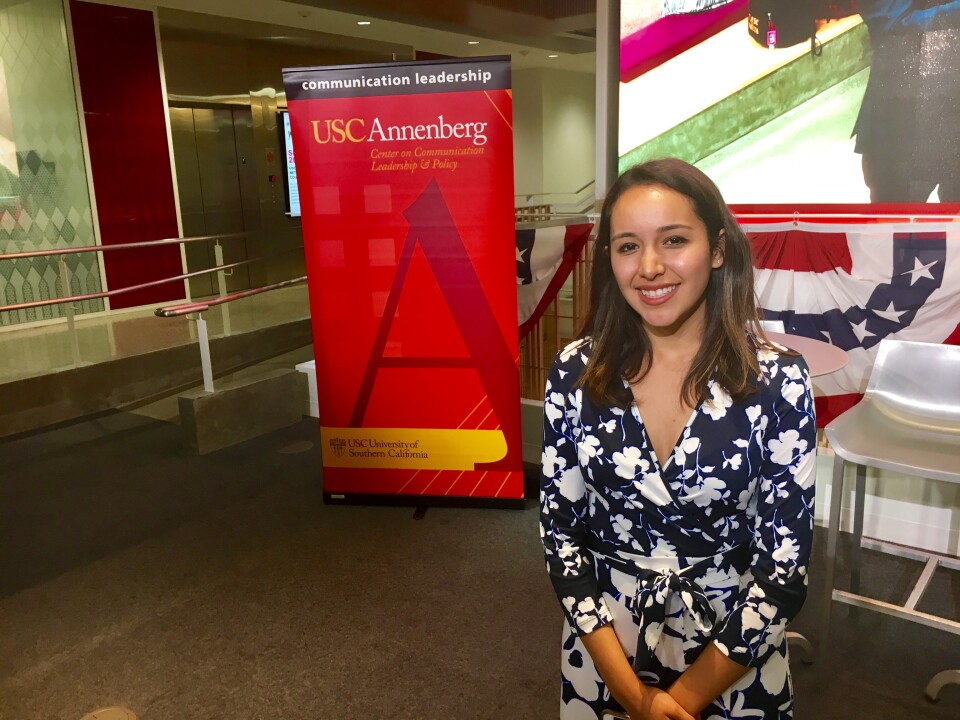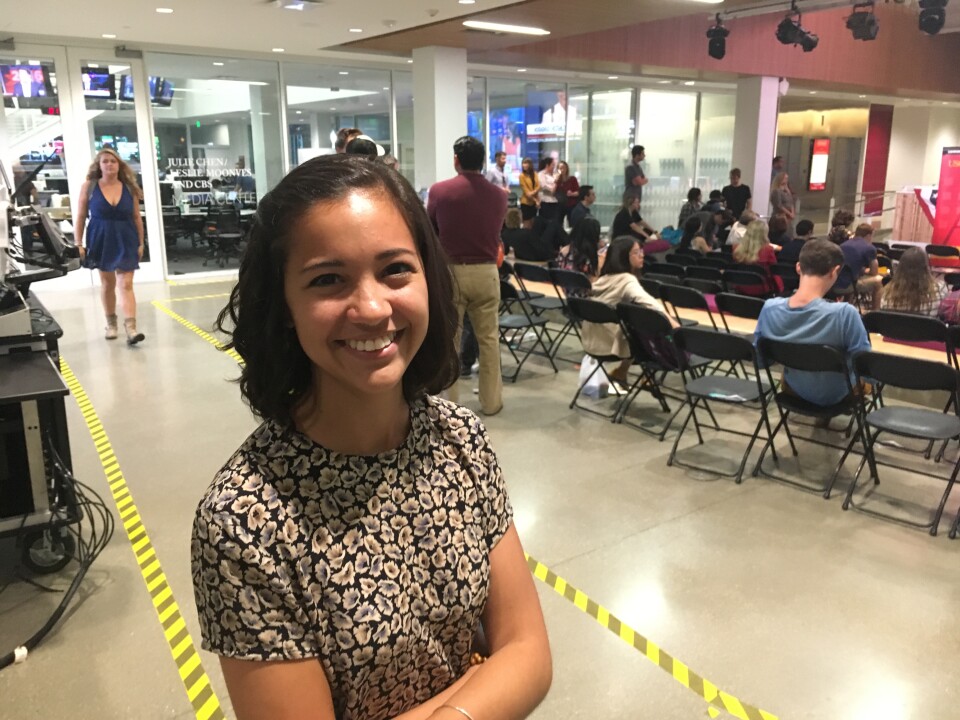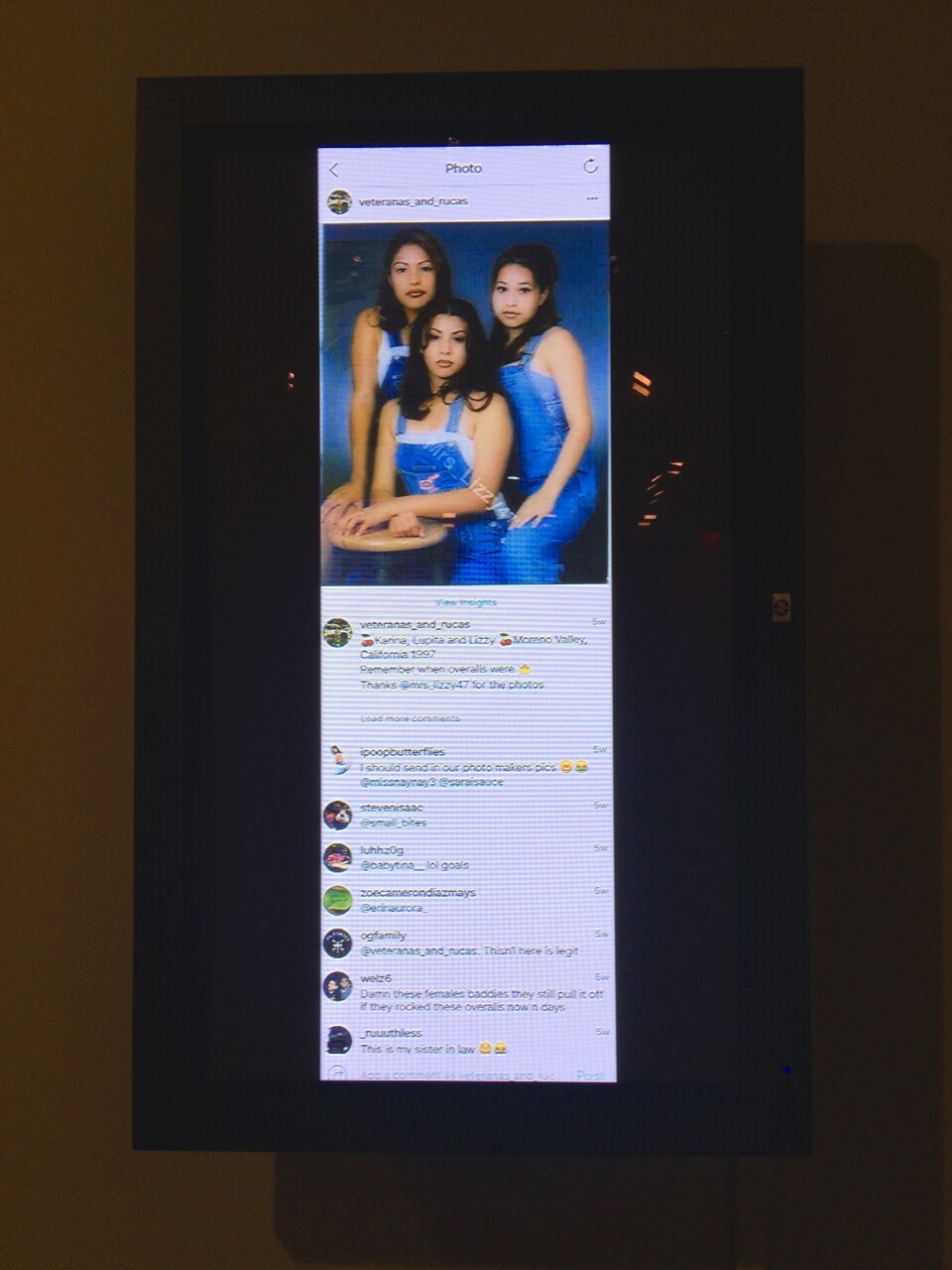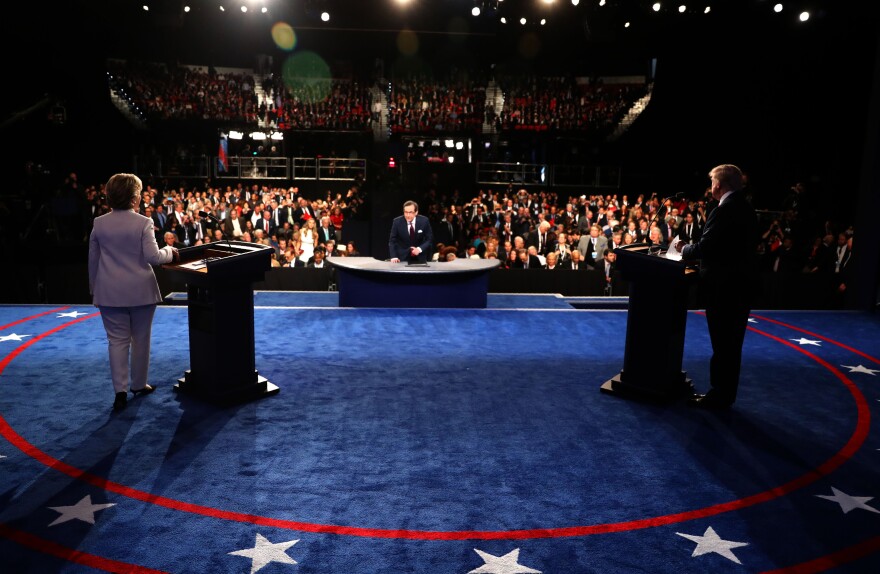Did last night's debate sway any voters? Can election numbers be manipulated by hackers? California's annual earthquake drill to keep your survival skills sharp.
The final presidential debate: SoCal reacts
Immigration, abortion, guns and trade were just some of the issues Hillary Clinton and Donald Trump tussled over in Las Vegas in the third presidential debate Wednesday night.
Initial ratings showed that more viewers watched this one than the previous debate, but fewer than the first one. Here in Southern California, younger viewers tuned in at USC's Wallis Annenberg Hall.
Take Two's Austin Cross and Jacob Margolis were there and spoke to some of the students and staff in attendance.
Ruben Duran

I was hoping that Chris Wallace had attacked Clinton more on Wikileaks because it shows her sleaziness, her dishonesty. He let her pivot away too much. When Wallace gave her a question about Wikileaks, before you know, they were talking about cupcakes and rainbows, you know what I mean?
I'm Mexican-American, and I totally understand Trump. We need a border, and it's really sad that Democrats and liberals are anti-border. Trump's strong, and he's not a typical politician. He speaks like us, he kind of acts like us. He kinda reminds me of a grandpa.
Mary Perez, vice president of the USC GOP

On Election Day, as I've said forever now, I will not be voting for Mr. Trump, but I will never be voting for Secretary Clinton so I will abstain from the presidential vote. But I will vote for down-ballot tickets, such as for state senate, and for state assembly and congressional races and I will vote for measures because those are the most important issues that affect our state.
Beverly Perez, and Mary Perez's mother (Republican)
We constantly battle over this. I tell her, you just don't get it; you're too young, you just don't understand. In my family, they all support Trump, and it's only because we are all conservatives because of what our moral beliefs are: we believe in pro-life, we're tired of paying taxes, we want to see the border closed.
Rachel Udabe (Independent)

If I had to pick one, I would pick Donald Trump because I feel like any bills that he would try to pass would just be shut down immediately. He has a lot of crazy things going on, and I think he would just be more of a figurehead and we'd be like 'Oh, Donald, be quiet, we'll handle these things without your input. Thanks, bye.'
Melanie Vera (Clinton supporter)
Trump acted the same way that I thought he was going to and Hillary actually surprised me because I thought she came out a little more aggressive than before. But like, with that white pant suit, she could pull off anything. So, I think she kind of won.
Dan Schnur, director of the Jesse M. Unruh Institute of Politics at the University of Southern California

I don't know that it changed a lot of minds among the fairly small number of undecided voters, but at this point in the campaign, the primary goal for both candidates is not so much to persuade undecided voters but to motivate their respective bases. Both of them probably did that pretty effectively.
More highlights from the night
They broke out the big, big screen tonight at @USC pic.twitter.com/PQ8tRgqTlG
— Austin Cross (@AustinCross) October 20, 2016
"I'm a conservative before I'm a Republican. I'd like to see us as a party eradicate Trump's brand." -Mary Perez at @USC watch party. @KPCC pic.twitter.com/XnAe9xCktH
— Austin Cross (@AustinCross) October 20, 2016
Most reaction from students tonight so far came from "bad hombres." @USC @KPCC #debate pic.twitter.com/xO9sBYhUDc
— Austin Cross (@AustinCross) October 20, 2016
I could hear the gasps from the fourth floor!
— Maya Lin Sugarman (@mayasugarman) October 20, 2016
.@realDonaldTrump slowly leans in and whispers "Wrong." @USC audience goes wild. @KPCC #debatenight
— Austin Cross (@AustinCross) October 20, 2016
Press the blue play button above to hear a full recap of the night.
(Answers have been edited for clarity and brevity)
(Correction 1: The web post and the segment that aired incorrectly identified the location of the event as the "Wallis Annenberg Center" instead of "Wallis Annenberg Hall." It has been fixed in this web post.
Correction 2: Dan Schnur is misidentified as the head of the USC political science department in the segment that aired. Schnur is the director of the Jesse M. Unruh Institute of Politics and USC Dornsife College part-time lecturer. We regret the error.)
News organizations haven't done enough to protect against cyber attacks, Politico report says
Cyber attacks have made headlines a lot in the past few years. From celebrities to governments, anyone of interest can be the target of malicious hacking. But what happens when a trusted news source becomes the victim of such an attack on one of the most important nights of the year?
Media organizations like The Washington Post, Newsweek, and BuzzFeed have already fallen prey to hackers. With the election quickly approaching, the question arises, what could happen if hackers tamper with election coverage - especially in a far-reaching and influential organization like the Associated Press?
For a deeper look, Take Two's Alex Cohen spoke with Darren Samuelsohn. He wrote about what a cyber attack on election night could look like and the potential fallout it could cause. He is Senior Policy Reporter for Politico.
To hear the full interview, click the blue arrow above.
Obama back in CA, the last debate, and the US Senate race
On this week's State of Affiars, President Obama appears in CA political ads, reaction to the final presidential debate, and a check-in on the U.S. Senate race.
Joining Take Two to discuss:
- Carla Marinucci, POLITICO's California Playbook reporter
- Marisa Lagos, KQED political reporter
The Ride: Tesla cars will be able to drive themselves
Elon Musk, the Tesla Motors CEO, revealed a new “product” for the company this week. It wasn't a new car really, but a dramatic shake up for the car industry.
All new Teslas, every model, will now be built to be fully self-driving. Here's a video that Musk tweeted out which shows how it would work:
Sue Carpenter, host of The Ride, joined Alex Cohen to talk about Musk's announcement.
Click the blue audio player to hear the full interview.
LA Sparks headed to Game 5 of WNBA Finals
With the Indians advancing to the World Series and the Dodgers and Cubs tying their series, you might have missed what else is going on in sports.
Thursday night in Minneapolis, the Los Angeles Sparks play the Minnesota Lynx in the fifth and deciding game of the WNBA Finals.
This series is between the two best teams in the league—that's because for the first time a new playoff system did away with tradition and pretty much rewarded teams for being good.
Mechelle Voepel, who covers the WNBA for ESPN, spoke to A Martinez from Minneapolis, where she had just stepped off the court after interviewing the Sparks lineup.
Click the blue audio player to hear the full interview.
Paralympic gold medalist Brad Snyder: When I swim, I don't feel blind
Creating something positive out of a tragedy isn't easy but after being blinded in combat, but Brad Snyder has done exactly that.
He won two gold medals and tied for a silver in the 2016 Rio Paralympics. Four years ago, he took home two gold medals in London in 2012—just one year after losing his sight in combat.
Now, he has written a memoir: Fire in My Eyes: An American Warrior's Journey from Being Blinded on the Battlefield to Gold Medal Victory.
Take Two's A Martinez spoke with Brad Snyder about coping with devastation, the road to recovery, and the inspiration he hopes to share with the world.
Highlights
The day Brad Snyder lost his sight
At the time, I was deployed to Kandahar, Afghanistan and I was deployed with a special operations unit whose job was to train, equip, and escort on operations these Afghan Commandos which is their version of special operations…. We were between two villages when two of our Afghan commandos stepped on an improvised explosive device….Both were unconscious and both were in really bad shape so we were in a very desperate medevac situation. So I was running around trying to help where I could and it turns out, I stepped on another improvised explosive despite the fact that I was clearing with a metal detector - at the time, I missed it….Luckily it blew up just a foot and a half in front of me which saved my limbs but unfortunately I took most of the blast to my face.
On regret and moving forward
A component of the entire story and a component of being able to pick up the pieces and move forward is, you can’t blame yourself forever. You make a mistake, you got to live with it. There are consequences to every mistake we make, but it doesn’t necessarily define us. I’m not defined on the failure, I’m define by how I picked up the pieces and moved forward.... Being able to do that was integral to me being able to transform, to re-identify myself, re-identify my purpose and then now, find a lot of value as a US Paralympian instead of a Navy service member.
From tragedy to gold medals
I didn’t realize at the time how blind I was because of all the drugs I was on when I was first in Walter Reed [Army Medical Center]. It took about a week to realize where I was and what was going on. To have a surgeon give you that sobering news: ‘yeah, we’re not going to be able to save your sight but the good news is we’re going to be able to save everything else.’ So, you’re dealing with some really difficult stuff and the emotion is very high… And people are calling me and leaving these very difficult-to-listen-to voicemails about how you’ve impacted their lives… and people are really devastated. My whole life goal was to be a positive impact to folks, to be inspiring, and to be uplifting….so I really hated this idea that I was the source of so much negativity to folks. I wanted to immediately show people, look I’m fine. Look at me live life the same I was when I had vision. The only difference is, I need a cane, or I need a guide dog, or my phone talks to me.
Shortly after being out of the hospital in Florida, I got to bump into my old friends that I swam with and my old coach…. It really just started as this way to show everybody, don’t worry, everything is going to be okay. I’m the same person I was before. It just turned out that based on my background as a swimmer and based on how good of shape I was in Afghanistan - all that kind of came together. Other folks were like, you should give this Paralympics a try and to be honest with you, I was resistant to the idea at first but got convinced to do it and it led to an incredible experience… and honestly led to a career I never would have anticipated for myself as a professional athlete.
Training with a disability
By and large, the training doesn’t change. We try as hard as we can to portray to everyone that Paralympians are elite athletes so we do the same thing that the NFL players do, that the Olympians do.
...Tactically, I changed the way I swam just a little bit. On my arm recovery, I keep my fingers very low on the surface of the water, looking for the lane line to make sure I’m swimming straight. Instead of flip turning the way I used to, I wait for a teammate or a coach to tap me at the wall with a long stick with a tennis ball on the end so to indicate, hey, you’re at the wall, you need to turn. I would use adjustments as a great word. We made some adjustments to be able to swim without my vision but by and large everything was the same. And that’s what I liked about it. When I swim, I don’t feel blind. I feel just the way I used to.
Finding inspiration in tragedy
The story I don’t get to tell is how hard the two years leading up to that were. It wasn’t necessarily blindness. I lost a teammate in Iraq, Tyler - he got killed by a roadside bomb and then a girl I had been dating succumbed to depression and committed suicide in 2010. I didn’t have very good life habits when I lived in Virginia Beach and I ended up getting a D.U.I. that almost ruined my career. Then, while in Afghanistan, I found out that my dad died. Not that I believe in it but I felt like destiny was really beating me down for a period of three years. I really struggled through all those things and really struggled to find who I was and what my purpose was.
….Finally I got the evidence I needed that if you just keep at it for long enough, things come back around. I think that’s why we wanted to write the book. That’s why we’re working on other projects - to get out there and share this story. I don’t go out to talk to audiences because I like to hear applause…it’s because I really learned a lot through really difficult experiences.
I hope that people can see themselves in this story and know, we all face these challenges. We all hit these high points and we all hit these low points….Hopefully my story can be a source of inspiration and hope to others who are going through similar struggles.
Click the blue audio player to hear the full interview.
Great ShakeOut Challenge: 2 LA chefs make a tasty meal with an earthquake kit
You know what to do in the event of an earthquake: drop, cover and hold on.
But what about getting prepared for an earthquake ahead of time? Do you have an earthquake kit ready?
Take Two producer Lori Galarreta took to the streets to ask Angelenos about how they're preparing for an earthquake...or not.
(Responses from: Joyce Chalfant, Fadi Farage, Andy Reyes, Paula Martinet and Melissa Miller)
The standard recommendation is that you have enough food, water and supplies on hand to last you and your family at least 72 hours after an earthquake.
As to what kind of food, that's your call, but items like canned food, dried fruit and nuts, and protein bars tend to fill up most earthquake kits.
Convenient? Sure. Long lasting? Yes. Gourmet? Not quite. But could they be?
Two L.A. chefs shared their tasty takes on disaster preparedness:
All-Purpose Baking Mix
From Noelle Carter, Los Angeles Times Test Kitchen director
Prep time: 5 minutes
Yield: Makes a generous 4 cups mix
INGREDIENTS:
- 4 cups (17 ounces) flour
- 5 teaspoons baking powder
- 2 teaspoons salt
- 4 teaspoons sugar
- ¾ cup nonfat milk powder
DIRECTIONS:
1. Whisk together the flour, baking powder, salt, sugar and milk powder to form the dry mix. Store in an airtight container in a cool, dry place up to 3 months.
2. To make pancakes: Whisk a generous cup of the baking mix with 1 to 2 tablespoons oil and about ¾ cups to form a batter. The batter will make about 4 pancakes.
3. To make dumplings or biscuits: Whisk a generous cup of the baking mix with 1 to 2 tablespoons oil and about ½ cup water to form a thick dough.
The mix is great for camping, but also works well in an earthquake kit as it requires no special ingredients or refrigeration.
Kushary
From chef, restaurateur, and cookbook author Susan Feniger
Yield: 12 cups
INGREDIENTS:
- 2 cups brown lentils, rinsed
- 1 ½ cups basmati rice, rinsed and soaked for 30 minutes
- 2 cups straight cut macaroni, par cooked to al dente
- 4 cups diced white onion
- 1/3 cup canola oil
- ¼ cup clarified butter
- 2 Tbl ground cumin
- 2 Tbl kosher salt
- 5 cups vegetable stock or water

DIRECTIONS:
In a rondeau, cook onions in the oil and butter until they start to caramelize.
Add rice and lentils and toast approximately 5 minutes, stirring regularly.
Add the cumin and the salt and stir to combine. Toast another minute or so to cook out the cumin, then add the stock.
Cook uncovered on a simmer until the liquid dissolves and the rice mix starts to crackle and toast on the bottom (you can stir occasionally).
Set aside.
Separately, crisp the pasta in:
- 1/8 cup canola oil
- 2 Tbsp unsalted butter
- ¼ tsp salt
- 1 Tbsp harissa chile paste
When done, add to the rice mixture and stir to combine. Pour out onto sheet pans to cool.
Pachucos to party crews: Art show uncovers a different side of LA's youth culture
Youth culture in Los Angeles is often represented by carefree surfer dudes, or bubbly teenage girls hitting the mall.
But one art show in East LA is putting a new perspective on what it means to be a young Angeleno.
Tastemakers/Earthshakers: Notes from Los Angeles Youth Culture, 1943-2016, explores how young Latinos have forged their own spaces and identities across time.
Fashion displays, videos and music, and even old issues of beloved publications like Street Beat magazine bring to life decades of Latino youth culture, from the pachucos and pachucas of the 1940s, to the party crew scene of the 1980s and 1990s.

Some artists even speculate about what the future could hold for LA's young Latinos.


Host A Martinez got a preview of the exhibit with Pilar Tompkins Rivas, director of the Vincent Price Museum at East Los Angeles College. He also spoke with Guadalupe Rosales. She's the creator of the popular Instagram account, Veteranas and Rucas, and one of the artists in the show.




